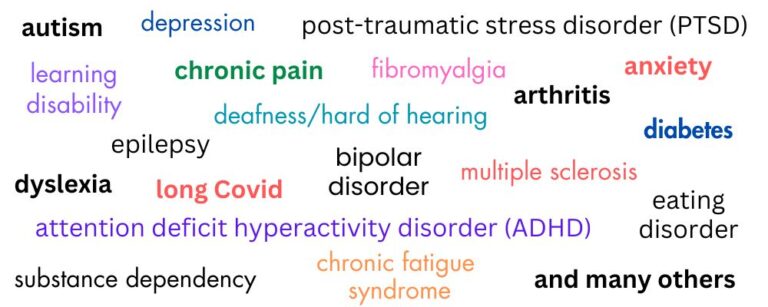Inclusive Workplaces
for Persons Experiencing
Invisible Disability
One fifth of the workforce in Canada experiences some form of disability, and the most common disability types can be invisible. When disability is invisible, people are more likely to downplay the severity of their symptoms and hesitate to request accommodations. There are steps employers can take to create a safe environment for disclosure and discussing accommodations.

Pour la version française de cet article, veuillez cliquer ici. | For the French version of this post, please click here.
In the photo above, can you tell which worker experiences disability?
One in five working-age persons in the Canadian labour force experiences some form of disability.(1)
Many workers have invisible disabilities that can be temporary or episodic (occurring on and off) and that can vary in the degree of severity. In today’s increasingly virtual environments, even physical disability can remain invisible.
A study found that employees with an invisible disability often feel excluded at work and receive fewer benefits. They may struggle in silence, feel unsupported, and be misunderstood. The resulting physical and psychological distress can put them at risk of social exclusion and poor well-being.(2)
Invisible Disabilities Week
October 20 to 26, 2024
The most common disability types reported by persons experiencing disability in Canada can be invisible:
- Pain-related 62%
- Flexibility 40%
- Mobility 39%
- Mental health-related 39%
Statistics Canada. Canadian Survey on Disability, 2017 to 2022. December 2023.
Invisible Disability Comes in Many Forms
While many disabilities are considered either visible or invisible, disability is often a spectrum between the two.

Severity of Invisible Disability Often Downplayed
When a person’s disability is invisible, others are more likely to downplay the severity of the symptoms. A finding from a Canadian qualitative study found that persons with invisible disabilities, particularly those with intersecting identities, frequently felt less credible, their disability not being understood, and being denied the disability supports they need.(3)
To reduce stigma and to “blend in,” persons with an invisible disability often manage their everyday interactions to appear as though they do not have a disability or to present their symptoms as signs of less stigmatizing conditions.(4)
Challenges of Requesting Accommodations for Invisible Disability
Accommodations can be requested in the workplace without disclosing the type of disability. This issue can become more complex for an employee when there is no “visible proof” of disability.
Will their employer believe them? Will the employer understand how the disability impacts them? Disclosure, particularly for people with more stigmatized disabilities, carries the risk of having your skills and ability to perform the job called into question or of impacting your relationship with your supervisor or co-workers.(4)
Disclosure can also illuminate the need for accommodations for invisible disability and help to positively shift an inclusive culture in a workplace.
Create a Safe Environment for Disclosure and Accommodation Requests
A person’s first-disclosure experience can influence well-being and fear or openness around disclosure for years. When support and positive feedback are received from an employer in a safe workplace culture, people feel a greater sense of trust in others and less social isolation.(4)
- Build a workplace environment where disability is understood as a different experience for every person. For example, two people with depression and anxiety may experience it in different ways, and our understanding of depression and anxiety may vary greatly from a person’s actual experience.
- Accommodations for a worker with an invisible disability may lead to stigma by other employees. Organize training for all employees around inclusion and accommodations in the workplace.
Communicate Regularly with All Employees
Accommodations are about managing effectively, rather than making exceptions. A good management practice in any setting is communication with all employees on a regular basis.
Conversations with an empathetic leader help employees, particularly those with an invisible disability, to speak more freely. In one study, teams with managers that were empathetic, patient, and willing to listen to team members’ experiences and to accommodate their requests reported a 63% increase in well-being and 71% increase in engagement.(2)
- Make yourself available for one-on-one discussions. Actively listen to a person’s experiences. Ask questions, but also do your own research to educate yourself.
- Explore each person’s unique needs. Research found that managers who used phrases such as “How do I set you up for success?” or “What can I do to support you to perform your best?” were seen as 92% more approachable by team members.(2)
Most importantly, no matter how busy you are, prioritize employee well-being and always follow up with their needs. Engaging staff in authentic conversations and providing them with what they need to feel like they belong will bring you as close to your business outcomes as any other urgent task on your never-ending to-do list.
Employee well-being is as important for business outcomes as any other urgent task on the never-ending to-do list.
References
- Statistics Canada. Labour force status of persons with and without disabilities aged 15 years and over, by age group and gender. Released March 28, 2024.
- Tillotson, Jack et al. How to Make Workplaces More Inclusive for People with Invisible Disabilities. Harvard Business Review. Published April 4, 2023.
- Department of Justice Canada. Serious Problems Experienced by Diverse People with Disabilities: Western Canada. January 18, 2022.
- Prince, Michael. Persons with invisible disabilities and workplace accommodation: Findings from a scoping literature review. January 2017. Journal of Vocational Rehabilitation 46(1):75-86. Copy of draft manuscript.

